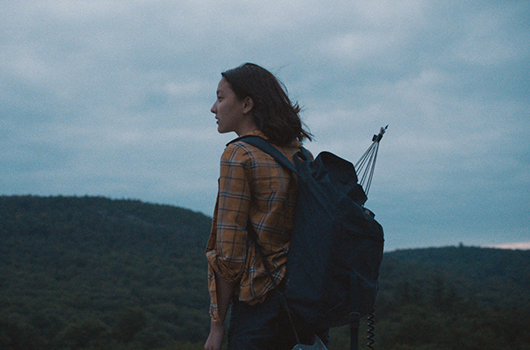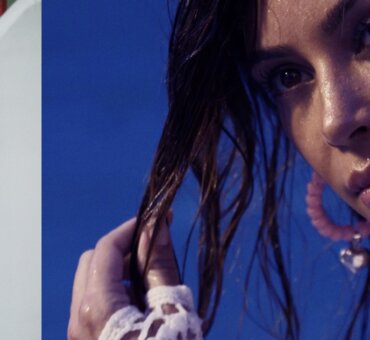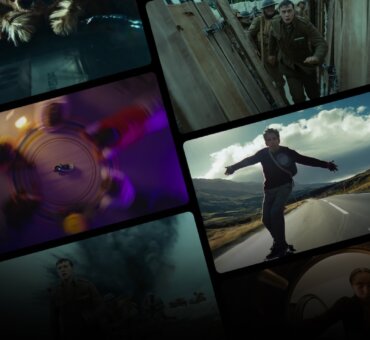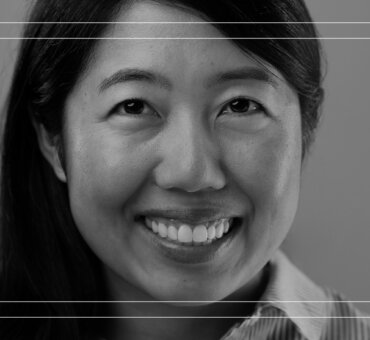Next month, National Geographic will premiere Mars, a six-part series created by Brian Grazer and Ron Howard. The show is a narrative exploration of what could soon be a reality: the colonization of Mars ⎯ mankind’s giant leap into life as an interplanetary species.
Mars is a big step not only for the network, but also for the network’s internal creative marketing team led by Senior Vice President & Global Creative Director Andy Baker. “We started thinking, ‘Okay, what can we do in conjunction with this show from a marketing content perspective that will expand the story of Mars and reinforce the idea of how humankind will make Mars home?” Andy told us. Soon, his team landed on one of their most ambitious ideas yet: creating a narrative prequel to Mars ⎯ a short film about identical twins Hana and Joon Seung, and the experience that put them on a trajectory toward the Red Planet.
The project ⎯ aptly titled Before Mars ⎯ pushed Andy and his team to their limit, both creatively and physically. But, per usual, they weren’t in it alone. As with many past Nat Geo projects, Andy recruited his friends and longtime collaborators, Variable, to help bring this ambitious project to life.
We talked to Nat Geo’s Andy Baker and Variable’s Tyler Ginter about the making of Before Mars.
THE ORIGIN STORY OF AN ORIGIN STORY
FS: What were those initial conversations like?
Andy Baker, Nat Geo: Well, the biggest question mark for me was that this was to be a scripted 30-minute film, and neither of us had done anything like that before. So it was like, is this even something Variable would want to do? Is this something they’d be interested in?
Tyler Ginter, Variable: We’ve worked with Andy for so long and on so many different types of collaborations — we were stoked about this project from the very beginning. This is a new season where advertising is really pushing its limits, and it’s the same for us at Variable. A lot of our early work ⎯ our foundation, really ⎯ is in visual language. We know how to evoke emotion and tell a story through visuals alone. So a longer scripted project like this was the next big step for us in terms of storytelling. Once you get to that 30-minute mark, it’s a whole new world. We were excited to take that leap with Andy and his team at Nat Geo. I think Andy and I agree that we dove into the deep end with this one. But sometimes that’s the only way you’re going to grow.
DEVELOPING THE STORY
FS: After you got off that first phone call, what did you do? Did you guys even know what to do next?
AB: There were so many things to figure out — it was staggering. First of all, we wanted to stay true to the show, and there were a lot of logistical things we didn’t know the answers to. They were writing the scripts [for Mars], and we were right there on that journey, asking questions about what the twins’ mom was like, what was the backstory they were creating for the series, how old the twins should be — that sort of thing. Before we could start writing the story [for Before Mars], we needed to know the rules of the Mars story, and we needed to know the characters. So the first few weeks were spent figuring out that logistical stuff. And then, of course, we had to figure out the actual story [for Before Mars].
TG: It’s fascinating to me that you don’t often hear about the early stages of creating these types of films. You usually see people on the set creating, executing, having all these great moments, and making all these great memories. But so much time before that is spent properly developing your story from scratch. The nice thing with this project is that we had constraints. We had to work with the characters and parameters of the actual Mars series. It’s amazing to have boundaries. But even with the boundaries we had, there was a lot of freedom. We went through hundreds of iterations of story lines and structures.
FS: How did you finally land on your story and its theme?
AB: From the beginning, we knew the theme was “home.” The show Mars is all about how we’re going to make Mars home. This isn’t The Martian where they sent people there and brought them back. This is like, you go, you stay, you colonize. So the idea of home was always key.
As we started learning more about the characters ⎯ kids traveling around with their mom because she worked for the military and was moving from place to place ⎯ we realized we had this built-in story structure of they’re moving to a new place. So then the question was “What happens next?” Like Tyler said, figuring that out is a long and winding road you don’t often hear about, but it’s also half the fun. There are so many different variables — no pun intended.
We had these really long calls every week to discuss story possibilities. I think Hurricane Katrina was somehow involved in one of the early versions. But I’ll never forget seeing an idea in a Word document that said something about the ISS — the International Space Station. And then Variable started doing some research and found out it’s possible to contact the ISS with a ham radio. It was one of those small victories that we’d have each week, which slowly grew into the story.
TG: There was never a big breakthrough moment. It was a series of small moments. That’s just the filmmaking process in general. It’s rare that this great idea gets slapped down on paper and then you go make it. I firmly believe it takes small steps made by a great group of people who can challenge each other and push each other. By no means did we agree on everything. But all of Andy’s experience and all the experience his team brought were really healthy for our team. As Millennial filmmakers and directors, I think sometimes we get too caught up in our niche audience. We sometimes forget there’s a much broader audience to tell stories to. One thing I’m most proud of is that this project can appeal to parents and children and people of all ages.
FS: So you guys worked out the whole story remotely?
TG: We had these weekly syncs, and then we’d go off on our own and brainstorm, which was really healthy during the early phase of the process. Ultimately, though, collaboration can only go so far without everyone being in a room together with a big whiteboard and Post-It notes all over the place. We were probably halfway through the development process when we started coming up against some serious creative walls. So that’s when Andy had the idea for all of us to meet in person at Variable’s office. During that meeting we came to this one awkward moment of silence. We’d hit a wall again. It was one of those times when I was thinking, Should we take a break? But Andy was like, “We’re finishing this. We’re getting through this wall.” And right then we came up with the ending.
AB: That was the big “Aha!” day. We all needed to get together in a room. You can’t fully collaborate over email and phone calls. You have to be in the same space together. I remember the moment we hit the wall that Tyler is talking about. We pressed through it, and I thought, What if in the end she’s trying to get a better connection to the space station? It snowballed from there. By the end of that eight-hour session, we had the basic story structure and plot.
FS: Having never done long-form stories, did you guys look up established story structures? Or did you wing it?
AB: I think we all know what makes a great story. A lot of it for me was going off my gut.
TG: This is where our writer and director really helped. They have a lot of experience in long-form content. They challenged us with a lot of traditional rules, but they also challenged us to break a lot of the rules in order to focus on the story.
FS: Do you guys like making up stories?
AB: I do like telling stories. But what I love are the details. What I’ve always loved about telling 30-second stories is that you can make every shot perfect. I was fortunate enough to hear Alejandro González Iñárritu speak this past year at Cannes Lions, and he was talking about how he got his start as a commercial director. And what he took from that experience was paying attention to the detail within every single frame of his films, which I think is a big part of any successful promo or commercial. If you have only 30 seconds to tell a story, you have to make every second count. His words really inspired me when it came time to work on Before Mars — to put commercial-level detail into the look and feel of a short film, to strive to make sure it all lived up to a certain quality level. We don’t just say, “Oh yeah, they’ll figure that out later on set.” We want to make sure all of those nuances of the story, all those little details, come through.
TG: Storytelling is why I got into this industry, so it’s a big honor to take a step into the narrative world. But as much as I love storytelling, it would be painful without the right people around you every step of the way. I know Andy and I talk about collaboration a lot, but it’s not just about tossing people into a room and hoping they’ll bring a story to life. I believe there are three aspects to great collaboration: time, trust, and taste. The three Ts. If you combine those three things over a long enough period of time, that’s ultimately what leads to telling great stories. For us, it’s not just about the end result; it’s about the process and the team.
AB: It’s also a hell of a lot more fun that way.
FINDING THE LOOK
FS: Before Mars has a very specific look. Almost retro? But not?
TG: That’s where Variable’s intuition put a stamp on the project. We love this feeling of nostalgia that could also exist right here in the present day. We sought the right locations for this film to make sure they brought up old memories but were also kind of timeless. We never wanted to make it feel like it was from a different generation, but we wanted it to have the nostalgia of previous generations.
AB: I think nostalgia is the key word there. And it really comes out in the details. We had long conversations about how old the mom’s Volvo would be. We didn’t want it to look ’70s, but we wanted it to evoke small town America. There were times we’d hide lamps on the set because they felt too ’70s; but at the same time, we wanted it to have a certain vibe and flair. We wanted everything to have a little bit of soul.
PRODUCTION
AB: It was a long shoot. We shot for seven days, and every one of them was a very long day.
TG: At least 12-hour days, sometimes 14, sometimes longer. They were grueling days. One thing we did that saved us was having multiple units that could divide and conquer. We had Lloyd Lee Choi, our director, and Kate Arizmendi, our DP, on the first unit. They were getting most of the main dialogue scenes. Then we had Jonathan Bregel as our second unit director, and he was out there every morning — sometimes at 3 or 4 a.m. — getting the sunrise and a lot of environmental cutaway shots that added so much breath and life into the film.
AB: The days were definitely grueling. But by the second day of filming, the crew and team were getting familiar with each other and starting to really gel and have some fun. We had a group WhatsApp thread that started as a simple way to communicate but, as happens with any group of creative people, quickly devolved into a full-on meme thread of moments on set. It was a small thing, but it brought us even closer as a team. When you’re the client and everyone around you is comfortable enough that they can take a funny picture of you and send around a meme at your expense ⎯ that’s when you know you’re in a very relaxed, creative environment. I truly believe stuff like that impacts what goes on the screen.
FS: Was there a moment when you knew everything was coming together?
AB: For me, it was on the third day of shooting. It was the mountaintop scene, which is the last scene in the film where the character is trying to contact the space station. We got lucky with the light and time and location. The actress was delivering her lines, and I got goose bumps. I could feel that, whoa, this is going to be good. I was watching the monitors, and I knew we had our ending, which is so important to me — to have a great ending. I watched that scene being filmed, and I was just like, “This is going to be killer.”TG: For me, once again, it wasn’t one big moment but a series of small moments every step of the way. Maybe it’s my left-brained, process-driven mind. Some of it didn’t connect until I started seeing all of it together. You start watching the first cuts and see it slowly working. That was a really fun experience.
AB: The last scene we shot was actually the first scene in the film. Tyler and his team had reserved a roller rink for the wrap party. The rental started at nine, but we didn’t end up getting there until midnight. And the party went late into the night. By then the crew was so close and we’d all connected so much. Everyone was just enjoying each other’s company, respecting everyone’s work and contribution. I think everyone had that feeling of, Wow, we made something really special, and we had a lot of fun doing it. And really, that’s why we’re all in this industry, right? To tell stories and have fun and meet great people? Having that night to unwind after a grueling, exhausting shoot was the perfect way to cap it all off.To explore more of Variable’s work and to license their footage, click here.
Get an in-depth look at how the best are doing their work, with these related articles:






